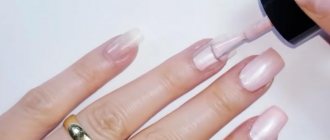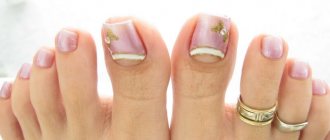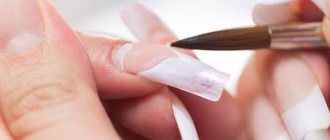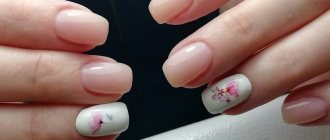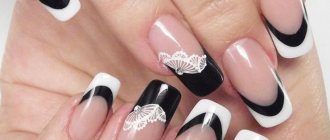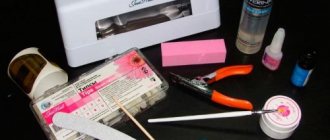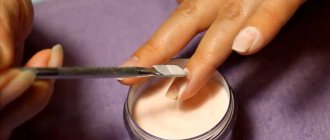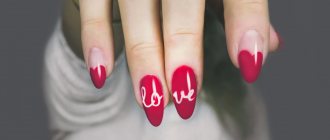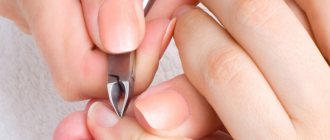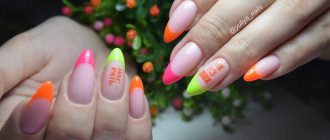Nail care at home and in the salon
Healthy nails look great even without an elaborate design. The use of various decorative means for decoration often leads to a deterioration of their condition, so taking care of the nail plates should become a regular habit. Home care is based on several rules:
- High-quality manicure tools are the main condition for healthy nails. For natural nail plates, glass, ceramic, and crystal files are the safest. They need to be filed in one direction.
- Care products should include hand cream, cuticle oil, and strengthening product.
- Regular warm oil baths for hands made of olive, almond, castor oils with the addition of lemon juice. Dipping your fingertips into lemon pulp will help whiten your nails.
- Intake of nutrition from food containing vitamins C, D, B, A, E. Food requires a sufficient amount of zinc, iron, iodine, magnesium, calcium, biotin, folic acid.
Salon nail care procedures: professional manicure, paraffin therapy, sealing, various types of extensions.
Acrigel
Acrigel (combigel, acrylic, polygel) - all these names belong to a universal material created on the basis of acrylic and gel. The material has absorbed their best qualities: gel plasticity and acrylic strength, and even surpassed them.
Extended nails are distinguished by their elegance, natural appearance, and effectiveness, on par with a professional salon manicure. The procedure allows you to quickly increase length. At the same time, the coating is very durable. The best polygel manufacturers are Irisk Professional, Bluesky Pudding Gel, Tnl Professional, Soline Charm.
Benefits of acrygel for nail extensions:
- The elasticity is superior to hard gels, the strength and lightness are higher than that of arkyl. There is no effect of squeezing the nail plate. Despite the high degree of density, the material is not felt on the nails and does not weigh them down, so it can be used on weakened nail plates.
- The dense and viscous consistency of the material allows you to give surfaces the correct architecture and ideal shape, thereby reducing material waste and saving time on the filing process.
- Acrylic causes 50% less burning when polymerized in a UV lamp, even when modeling very long and dense nails. There are no harmful fumes.
- Acrygel does not spread, so there is no risk of accidental contact with skin. This sets it apart from regular gel.
- The dust created when filing acrylic materials is 30% heavier than regular gel or acrylic. When working, it does not fly apart, but settles on the skin and table. This property reduces the risk of contact and respiratory allergies of the nail artist and the client.
- Unlike acrylic, acrylic does not require the artist to follow strict proportions of combining powder with monomer.
- Excellent adhesion of acrylic with primer and base, as well as any type of varnish, allows you to avoid peeling.
- Acryl Gel can only harden under a lamp. Therefore, you should not be afraid of sunlight hitting an open jar of acrylic. This is its advantage over acrylic.
- Combigel is very economical. One layer of material allows you to obtain a uniform and dense coating. There is no need to purchase separate brushes. Those used in working with gel and acrylic are suitable. The absence of an unpleasant odor allows the master to do without a separate office.
Note! The correct shape is created both by directly applying the material to the nail plate and by using accessories: regular or liquid tips, reusable forms. Combigel lasts until correction is required due to overgrown natural nails.
Basic terms
Top forms are a soft plastic product that imitates a natural nail plate and helps create an artificial nail of the desired length and curve. Unlike conventional blanks, they are installed on the nail, and not under it.
The product is odorless and has increased density, which makes it an excellent material for modeling artificial nails. Available in tubes or jars with a lid.
Depending on the bend, there are 3 types of upper forms:
- Natural. Light bend, close to natural;
- Classical. More convex in the center of the structure;
- Standard. The most convex. The result is a nail with a slightly drooping tip.
The specific type is selected based on the data of the natural nail - the bending of the transverse and longitudinal arch is assessed, as well as the desired shape of the extension.
- A natural curve is used for the final result, a crisp or rounded square;
- For future nails, the “Almond” shape is standard;
- For an oval – classic.
But this relationship is conditional - you can use any bend, but in some cases this may increase the operating time.
A few important points:
- The upper forms have their own size range, which is determined by the numbers embossed on the plastic. The larger the number, the smaller its size. Depending on the manufacturer, the largest figure may vary. Common numbering of sizes is from 1 to 10;
- Depending on the manufacturer, it can be with or without printed lines. The marks on the plastic are intended to determine the length of the future nail and carefully lay out the material. Forms with markings are offered by dozens of manufacturers, for example, PNB, Formula Profi, Monami, Vogue Nails;
- There are small handles at the ends of the plastic blanks - they help separate the plastic without damaging the artificial nail. Find forms with handles from the brands Monami, Vogue Nails;
- On the upper forms, extensions are done with any type of gel. But most often it is polygel that is used, since it has a dense texture and does not “roll off” from the sides. When choosing a product, pay attention to the brands Canni, Vogue Nails or Patrisa Nail.
Polygel extensions at home
Step-by-step instructions for acrylic gel nail extensions will help you carry out the process at home. To do this, you need to purchase a set for modeling nails with polygel. Professional equipment includes all necessary materials:
- 4 polygels (clear, white, light pink, camouflage pink);
- construction fluid for leveling acrygel;
- bonder, dehydrator;
- acid-free primer;
- classic finish gel;
- sticky layer remover;
- brush, spatula, clamps for squeezing polygel out of the tube.
Preparation consists of a thorough manicure, cleansing and dehydration of the nail plates.
How to extend onto upper forms
The top shapes help you to grow your nails into the perfect shape without much effort. The duration of the procedure is reduced to 40 minutes. Process algorithm:
- Forms are put on the prepared nail plates and a base coat is applied.
- A ball of acrygel is squeezed out of the tube, picked up with a spatula, and applied to the nail. The brush is moistened in a special anti-stick liquid.
- Begin to distribute the polygel from the cuticle, to the side rollers, over the entire surface. You can add material without worrying about noticeable transitions.
- The nail is dried in a diode lamp for 30 seconds.
- The mold is removed and the nail is clamped to create an arch shape.
- It is given the ideal shape using a file (180-240 grit) and a buff.
- Apply top coat or gel polish.
How to grow without forms
The nail is degreased, covered with a layer of primer and allowed to dry for 1 minute. If the nail plate is dry, then you can do without a primer. Step by step process:
- A little acrygel is squeezed out of the tube, a drop is removed using the flat side of a spatula. Apply to the nail.
- The brush is moistened in the construction fluid so that the bristles do not stick to the material. Acrigel is easily pressed onto the first third of the nail plate.
- The nail is formed by distributing the material according to the principle of a gel for extension.
- Dry in a UV lamp for 2 minutes or in an LED lamp for about 30 seconds. Remove the sticky layer, if any.
- The surface is smoothed using a file (180 grit).
- Before applying gel polish, the nail surface is coated with a primer. Then it is dried in a lamp, a layer of topcoat is applied, and dried again.
This is interesting: Oil for strengthening eyelashes 2022
Nail extension with polygel on tips
How to extend nails onto tips with polygel? For this method, you will additionally need to prepare a set of suitable tips, wire cutters for cutting them, and glue for the tips. The nails are carefully prepared, the tips are laid out in order. Procedure:
- On each frame, the edge of the contact zone is filed.
- The nail plate is degreased and glue is evenly applied to the contact zone.
- Holding the backing at an angle of 45 degrees, apply from the edge to the middle of the nail plate.
- The frame is pressed for 15 seconds until it fully adheres to the nail.
- After final fixation, adjust the shape of the tips using a tip cutter and file. The file is passed over the entire surface of the substrate to ensure better adhesion to the acrygel.
- An acid primer is applied and dried.
- Then apply an acrygel ball and distribute it evenly over the entire surface, starting from the cuticle. If necessary, add polygel again.
Further steps for acrylic extensions are similar to the previous options.
Acrylic gel extension method
How do top forms differ from liquid tips?
Many people think that liquid tips and top forms are the same thing. In fact, this is a false statement. Because coating technologies are completely different. In liquid tips, only gel, that is, flowing material, is used as a material. In this case, the tip is not applied to the entire nail, but only to 2/3. The main difference is that after removing the upper forms there is no need to file the surface of the nail, because it is already ready.
With liquid tips, the master must do a lot more work, since the material does not cover the entire nail. That is, it will be necessary to lay out the gel in the cuticle area, as well as level the surface. In the same way as this is done with the lower paper forms, only here the already formed tip of the nail acts as a substrate using gel and liquid tips.
Most often, liquid tips are disposable, while the upper forms can be used several times in a row. As a result, the time spent on nail extensions using liquid tips and top forms differs significantly. Modeling nails using top forms takes approximately 60-90 minutes, while liquid tips will take much longer. Most of the time is spent on finishing and laying out the material after the formation of the substrate.
Advice from experienced manicurists
A novice nail extension artist has plenty of opportunities to learn independently using video tutorials or articles on the Internet. It’s better to take real master classes from professionals. They can share their secrets and valuable information. Here are some of the tips:
- To create a three-dimensional design, polygel can be mixed with gel polish.
- To avoid detachment, when applying the material must be carefully pressed against the cuticle.
- The impermeable film created by gels, varnishes, and acrylics serves as a breeding ground for bacteria and fungi. Therefore, disinfection is necessary when using decorative coatings.
- You need to file your nails after they are completely dry. A wet nail plate is very vulnerable to mechanical stress and may begin to peel off.
- Nails need to be given periodic rest to recover, and not even use nail polish.
All stages of the process, from nail preparation to extension and design, are similar to techniques for working with gels and gel polishes. If you have the skill of building extensions with these materials, mastering the use of acrygel will not be difficult.
Varieties
Today, two types of upper forms are known. Depending on the cost, they can be either with or without markings to facilitate the work process. The first option is especially convenient for beginners who are getting acquainted with nail extensions using such templates.
The markings on the forms may differ; in some places they are arched stripes, in others they are a grid.
The set has the same arch and length, as well as markings with the indicated dimensions. Based on the marking lines, it is easier to align the length and adjust the edge. There is no need to tediously adjust an identical shape, since it already exists.
The upper forms are classified as reusable types of extension templates. They differ from arched counterparts and liquid tips.
Strengthening and extending nails with polygel
Acrygel (acrylic, acrylic gel, polygel) - all these are different names for one easy-to-use material that allows you to create short and medium length nail extensions or strengthen the plate without preliminary mixing.
- good flexibility
- lightweight - does not compress the surface of the nail bed,
- does not have a strong odor when applied or dried,
- when filing and removing, dense heavy particles are formed, which quickly settle on the table or in the hood without floating in the air,
- Can be worn alone or under gel polish.
For artists who perform extensions using gel or acrylic materials, polygel will not create inconvenience in their work.
The application process is practically the same and therefore no new courses will be required.
Available packaging formats: tube or jar.
What types of acrylic gels are there?
- In banks
- In tubes
The material in the cans is a little softer than in the tubes. Each manufacturer mixes acrylic and gel in different proportions, which is why the density and consistency may vary slightly.
How to remove acrylic
A 160-200 grit file or router is suitable for removing material. Soaking polygel is useless and harmful to nails.
Strengthening with acrylic - a step-by-step process
- manicure tools or apparatus,
- buff,
- clinser,
- dehydrator (optional),
- primer (optional),
- base,
- brush,
- polygel,
- liquid for polygel (if included),
- top,
- gel polish (optional).
We prepare the nail plates and cuticles well, then proceed to strengthening.
- We do a clean manicure (file, remove cuticles, clean up the eponychium, buff).
- We wipe the nails with a cleanser; if the nails are wet/oily, we then go through an additional nail prep/dehydrator.
- Next comes the primer, but with caveats:
- dry nails do not require an additional layer to improve adhesion; as a rule, any long-term coatings wear well on them,
- Apply a very thin layer of acid-free primer to damp nails and let it air dry for 60-120 seconds.
- The base line - you can use a special one for polygel, or your favorite perfectly worn top from any manufacturer will do. Apply with thin rubbing movements over the entire nail, don’t forget about the end and dry in a lamp.
To apply acrylic you will need a brush; it can be synthetic or with natural bristles; it is especially convenient to work with a flat or semicircular one.
Before spreading the acrygel, the brush must be moistened/moistened (so that liquid does not flow from it) so that the material does not stick.
Ideal: a special product from the manufacturer, or a cleanser or nail prep.
You can dip the brush into the liquid and remove the excess on a cotton pad, or wet the disc well and apply to wet the brush.
- Take a drop of polygel from a jar (squeeze out a small pea from the tube and remove it with a spatula) and apply it to the first third of the nail. We distribute it like an extension gel.
- First, we press the acrylic a little with the brush and bring it close to the cuticle, leaving a space into which you can move the brush. Next, using short strokes, we go down to the free edge of the nail, reducing the acrylic gel to almost zero. For convenience, you can first form the acrygel into a plane over most of the nail plate, and then carefully go down to the free edge.
- Working with polygel is very convenient; excess, which may form at the edge of the nail as it is distributed, can be removed with a brush and put aside (for example, on the lid of an acrylic gel container) and used on another nail. Or you can cut everything off after polymerization.
- If necessary, the brush can be slightly moistened (when the mass does not stretch well and begins to stick) and continue distributing the polygel over the nails.
- When the nail is ready, the polygel may look somewhat rough, now we moisten the brush in the cleaner a little more and, without strong pressure, move it over the polygel, creating a smooth, shiny surface.
- As smoothing proceeds, a little more excess acrylic may form from the end; they can be immediately removed with a brush or later cut off (this excess can no longer be used in further work). It is important that the material does not get under the nail and into the cavities - this will lead to chips and detachments.
- Before placing your nail in the dryer, you can let the nail sit for a while to smooth out the grain slightly.
- We send the nail to a UV lamp for 1-2 minutes, or to ICE for 30-60 seconds.
- If it was not possible to create a perfectly flat leveling surface, we saw it. Files of 180-240 grit are suitable. Next you need to buff the surface from scratches; a roughness of 180 will do.
- Next steps: you can apply a top coat and leave the nails nude, or apply the gel polish system step by step.
This is interesting: How to apply eye cream correctly
Strengthening nails with polygel according to the described scheme takes very little time, and most importantly, with proper skill, you will not need to waste any time on final sawing.
More detailed instructions for extensions
First stage
- After disinfecting the palms and fingers with an antiseptic, we treat the nail plates.
- Use a wooden stick to push back the cuticle. It is advisable to trim off the excess using special nippers or sharpened nail scissors.
- Carefully file the nails, leaving approximately 1-5 mm. Use an orange stick to remove dirt under your nails.
- The top glossy layer is removed with a buff and unevenness is removed. Use a brush or brush to shake off the dust.
- We degrease the nail plate using a special product. At home, you can use alcohol to soak a napkin.
- A primer is applied, it ensures adhesion of the material to the nail plate and protects against microbes.
Second phase
After the nails are processed, we select the upper forms of a suitable size, one by one applying them to the nail plate.
The blank should be slightly smaller than the nail plate. The free space will be filled with excess gel.
- The nail is covered with a thin base layer of gel. It should not be dried out.
- The inside of the workpiece is carefully filled with a denser layer of material in the area of the free edge, which should be dried after application (20 seconds). The gel is then applied to the area intended to adhere to the nail plate.
- The procedure can be simplified. A thin layer of gel covers the part of the plate that comes into contact with the nails. The free edge of the workpiece is compacted more tightly (0.5-1mm). At this stage of modeling, you can also determine the approximate desired length of the nail.
- The gel-filled blank is carefully pressed against the nail. There is no need to put pressure on the plate. Turning your palm over, you need to see how the gel lays down; its excess is removed with a pusher.
- Fingers with applied tips are placed under a UV lamp for about five minutes and wait for the material to polymerize. Manufacturers indicate on the packaging how long it takes for the material to harden.
- Once the gel has hardened, the top molds are carefully removed. We wipe the tip and put it back in the box. The nail is degreased. The free edge is processed with a file, which is given a neat appearance.
- To consolidate the result, this extension technology provides the possibility of applying a finishing coating. It is advisable to do this, but there is no particular need. This layer is polymerized for about two minutes.
- Degrease the nail plate. Lubricate the cuticle with special oil.
How to extend nails with polygel
If you need to do nail extensions with acrylic, three options are used: on forms or top forms, liquid tips.
Before any method of extension, it is necessary to do a high-quality manicure, followed by cleaning and dehydration of the nails; if necessary, an acid-free primer is also added.
VIDEO REVIEW » alt=»»>
Acrylic extension onto molds:
- We put the forms on the prepared nails. If the system has a base, we make a thin coating.
- By analogy with strengthening, we wet the brush so that the material does not stick to it.
- Let's start with polygel extensions. Place a ball of acrylic on the nail. The distribution occurs from the cuticle (we distribute it in a very thin thin layer, without driving it under the cuticle). Next we move to the side rollers - this zone also smoothly descends into a thin layer. Gradually, with short movements, we go down, building the shape and length. If necessary, the material can be added a little; it blends well and does not leave “patches.”
- Place the nail in a diode lamp for 30 seconds. Afterwards, carefully remove the form and clamp the nail, creating an arch. Then we put on the extension clip and send it to the lamp to dry for 30 seconds.
- Next, if the extension is done correctly, you can proceed to a small sawdust, take a file of 180-240 grit, no lower. We use a file without strong pressure, the material is very soft and lends itself well to filing.
- Next we buff for perfect alignment.
- For the final coating, you can apply a top coat or apply gel polish.
Acrylic extensions on top forms - video instructions » alt=»»>
Master class on extensions to upper forms, quickly and without unnecessary sawdust.
How to remove acrylic
Nail preparation
Before the extension procedure, you need:
- Get your nails in order, trim off excess length and polish.
- Choose the right place for the procedure so that there is sufficient lighting.
- Wash your hands with soap.
- Treat the cuticles with antiseptics to prevent the gel from peeling off after hardening.
- Remove all small particles of skin from under the nail plates.
- Sand the free edges for gel extensions.
- Process with a nail file, starting from the edges closer to the center.
- Remove shine from nail plates.
- Clean your nails with a brush and sharpen them with a hard nail file.
- Degrease.
Next, you can begin to attach the stencil, apply a base layer of gel with a brush, lower it into an ultraviolet lamp to harden, and then file the nail to give the desired shape and length.
All that remains is to apply a layer of gel and the desired pattern with paints, varnishes, or you can use ready-made stickers as a stencil.
It is important to make sure that there are no contraindications for the gel procedure or allergies to gel materials.
It is not recommended to take antibiotics or other hormonal drugs the day before that can reduce the quality of work or the desired effect.
We must not forget that household chemicals are used, so it is necessary to carry out the extension procedure while wearing protective gloves.
In the future, it is necessary to carry out corrections every 2-4 weeks so that the nails always look neat and beautiful.
Preparation consists of:
- treating hands with antiseptics;
- removing the varnish coating and old gel layer;
- cleansing the surface of the nail so that air bubbles do not form under the new layer due to polymerization from exposure to an ultraviolet lamp;
- applying a fresh layer of gel;
- sawing off unnecessary parts of the stencil to give the desired shape to the nail.
What is polygel?
For many years, nail technicians couldn’t decide: Which is better, gel or acrylic? Each material has its own advantages, it would be nice to combine them. And lo and behold, it happened. A unique product, Polygel, was created that combines the advantages of these two materials. Everyone wanted to buy polygel! Today it is the most popular product in World of Cosmetics stores.
Benefits of Combigel
New material - new possibilities. Combigel is hypoallergenic, safe and economical. And working with polygel is a pleasure. Both beginners and professionals are eager to buy combigel. Due to its hypoallergenic nature, it allows girls who are allergic to chemicals and odors to do nail extensions.
Why should you buy polygel
- After sawdust, heavy dust is formed, which does not float in the air, but immediately settles on the table. You don't need a protective mask, glasses, a screen or a vacuum cleaner. And this is a big savings on consumables.
- During the drying process, the polygel does not form harmful fumes, so it is ideal for asthmatics and allergy sufferers.
- Combigels do not spread, and therefore the risk of polygel contact with the skin is minimal. They self-level and do not stain the side ridges and cuticles.
- You don't have to rush. With combigels you can work at a comfortable pace.
- Craftsmen do not need to spend precious minutes mixing different materials, as is the case with acrylic technology. This time can be spent creating a unique nail look.
- Acryl Gel does not dry in the sun, but only in a lamp.
- If you decide to buy Jess Nail or Bluesky polygel, you will be able to grow long nails without a strong burning sensation during drying.
- Acrylic is stronger and more elastic than gel and acrylic. It does not weigh down the nails, so it can be used on weak nails. The results are strong and elastic nails that last a long time. During wear, the polygel does not cause peeling and looks very natural.
- Combigel does not require the purchase of new tools. To work with it, the brushes that you used to work with gel and acrylic are suitable.
This is interesting: Do-it-yourself busy board for girls
Well, how did you become convinced of the benefits of polygel? Then we are waiting for you in the World of Cosmetics stores, where you can buy Bluesky and Jess Nail combination gel at competitive prices.
How to work with polygel
We present to your attention a master class from IREN PRO NOGTI.
From this video you will learn:
- how to strengthen your nails with polygel,
- how to quickly make a design.
We wish you pleasant viewing!
How to strengthen your legs with polygel
:
- Before applying the polygel, apply a thin layer of Charme Rubber rubber base and polymerize.
- We apply the polygel to the nail and begin to distribute it with a brush. (If the brush begins to stick to the material, wet the brush in degreaser)
- We polymerize and smooth the nails with a nail file.
- Let's start covering with pastel color.
- Apply the top without a sticky layer.
* For polymerization, we recommend using 48 W LED nail lamps.
** Due to the complexity of the pigment, we recommend applying pastel shades in two layers.
You can buy polygel in our online store with delivery worldwide.
Thank you for watching.
